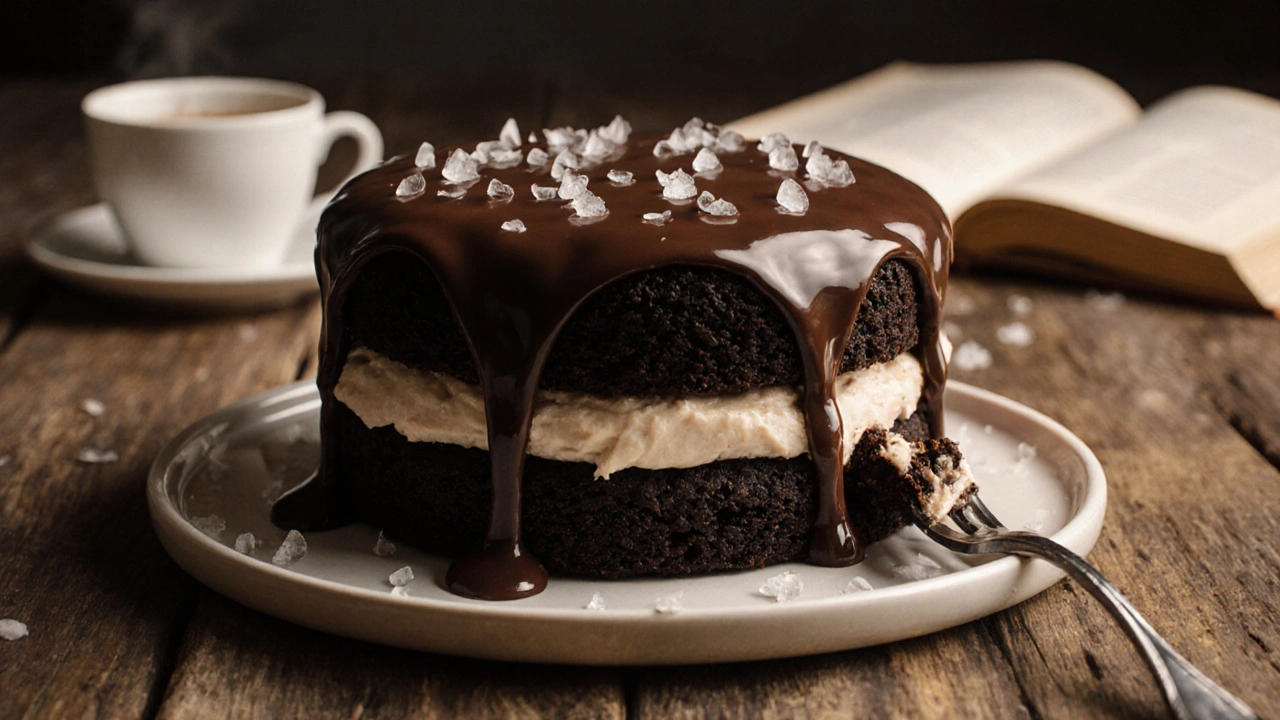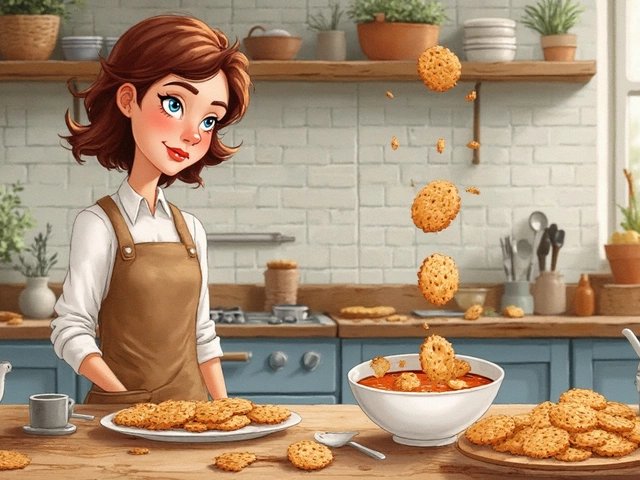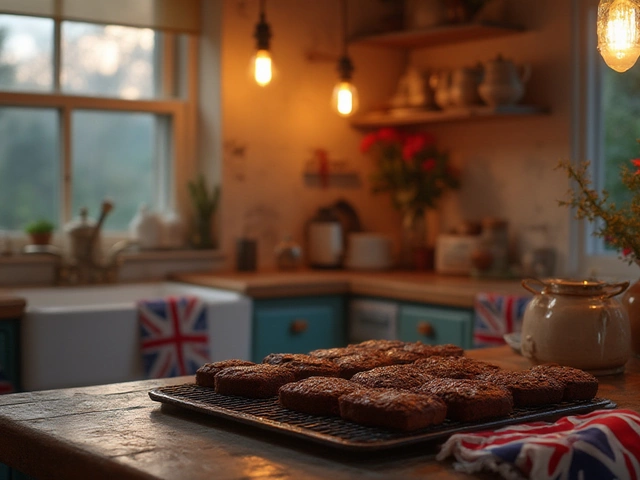Chocolate Cake Flavor Balance Calculator
Optimize Your Chocolate Cake
Based on the article's science of flavor balance and emotional impact, adjust these parameters to create the perfect chocolate cake:
Your Cake Balance Score: 7.2/10
Excellent balance between chocolate complexity and sweetness
There’s no single answer to what is the best cake on Earth-but there is one that comes closest to winning everyone over. Not because it’s the most expensive, the most Instagrammed, or the fanciest. But because it balances texture, flavor, and emotion in a way no other cake does. That cake? The chocolate layer cake with ganache and a hint of sea salt.
Think about it. You’ve eaten birthday cakes with neon frosting. You’ve had wedding cakes that cost more than your rent. You’ve tried exotic desserts from Tokyo, Paris, and Mexico City. But when you close your eyes and remember the cake that made you pause mid-bite? It’s probably chocolate. Not just any chocolate. The kind that melts slowly on your tongue, the kind that doesn’t scream sweetness but whispers richness. The kind that pairs perfectly with coffee, ice cream, or nothing at all.
Why Chocolate Layer Cake Wins
Chocolate cake isn’t just popular-it’s universal. A 2024 global dessert survey by the International Food Information Council found that 68% of people across 32 countries named chocolate cake as their top choice, beating out tiramisu, red velvet, and carrot cake. Why? It’s not just about cocoa content. It’s about structure. A great chocolate cake has three key layers: a moist, tender crumb; a smooth, velvety filling; and a glossy, slightly bitter glaze.
The crumb comes from using high-fat Dutch-processed cocoa powder, not cheap supermarket cocoa. It’s mixed with buttermilk, which tenderizes the gluten and keeps the cake from turning dense. The filling? A simple ganache made with 60% dark chocolate and heavy cream, heated just until the chocolate melts. No butter, no sugar syrup-just chocolate and cream, cooled slowly so it thickens without becoming stiff.
The topping? A thin layer of that same ganache, then a sprinkle of flaky sea salt. That salt doesn’t make it taste salty. It makes the chocolate taste more like chocolate. It’s science. Sodium enhances flavor perception, especially in bitter compounds like cocoa. That’s why professional chocolatiers always add a pinch.
Other Strong Contenders-and Why They Fall Short
Red velvet cake? Beautiful, yes. But it’s more about food coloring than flavor. The buttermilk and vinegar give it a tang, but the cake itself is bland without the cream cheese frosting. And that frosting? It’s delicious-but it’s not part of the cake. It’s a separate entity. You can’t eat red velvet without it. That’s not a cake. That’s a dessert with a side.
Tiramisu? It’s layered, elegant, and deeply Italian. But it’s not a cake. It’s a dessert made from soaked ladyfingers and mascarpone. No baking. No leavening. No crumb. It’s a parfait with caffeine. It belongs in the same category as panna cotta-not chocolate layer cake.
Carrot cake? Spiced, moist, and full of texture. But it’s a vegetable dessert masquerading as cake. The carrots add moisture, sure, but they also make it taste like a salad with icing. It’s loved by many, but it’s not the kind of cake you crave at 2 a.m.
Even the famous Black Forest cake, with its cherries and whipped cream, falls apart under pressure. The cherries release juice. The cream deflates. The chocolate shavings melt. It’s a beautiful cake for a special occasion-but not one you’d make on a Tuesday.

The Science of Crumb and Comfort
Psychologists at the University of Oxford studied food memories and found that people associate cake with safety, celebration, and childhood. But not all cakes trigger that feeling equally. Chocolate cake activates the brain’s reward center more intensely than any other. Why? Because it hits three pleasure triggers at once: fat, sugar, and bitterness.
Fat gives richness. Sugar gives sweetness. Bitterness gives depth. Together, they create what food scientists call a “flavor bridge”-a sensation that pulls you back for another bite. Vanilla cake? Just sugar and butter. Lemon cake? Too sharp. Spice cake? Too many competing flavors. Chocolate cake? Balanced. It doesn’t overwhelm. It invites.
And texture matters just as much. A good chocolate cake should have a slight spring when you press it. Not too soft. Not too firm. It should crumble slightly when you cut it, but not fall apart. That’s the difference between a cake made from scratch and one from a box. Box mixes use emulsifiers and stabilizers to extend shelf life. They don’t care about texture. They care about consistency. Real cake? It’s unpredictable. And that’s why it’s better.
How to Make the Best Chocolate Layer Cake
You don’t need fancy tools. Just a mixing bowl, a whisk, two 8-inch round pans, and patience. Here’s how:
- Preheat your oven to 350°F (175°C). Grease the pans and line the bottoms with parchment paper.
- Whisk together 2 cups of granulated sugar, 1¾ cups of all-purpose flour, ¾ cup of Dutch-processed cocoa powder, 2 teaspoons of baking powder, 1½ teaspoons of baking soda, and 1 teaspoon of salt.
- Add 2 large eggs, 1 cup of buttermilk, ½ cup of vegetable oil, and 2 teaspoons of vanilla extract. Mix until smooth.
- Pour in 1 cup of hot coffee (not boiling). Stir until combined. The coffee deepens the chocolate flavor without tasting like coffee.
- Divide the batter evenly between the pans. Bake for 30-35 minutes, or until a toothpick comes out clean.
- Let cool completely. While cooling, make the ganache: Heat 1 cup of heavy cream until steaming, then pour over 12 ounces of chopped 60% dark chocolate. Let sit 5 minutes, then stir until smooth.
- Place one cake layer on a plate. Spread ¾ cup of ganache on top. Add the second layer. Pour the remaining ganache over the top and let it drip down the sides.
- Sprinkle with flaky sea salt. Refrigerate for 1 hour before slicing.
That’s it. No buttercream. No fondant. No sprinkles. Just chocolate, salt, and time.

Why This Cake Works Everywhere
From Halifax to Hanoi, from Nairobi to New York, this cake doesn’t need translation. It doesn’t rely on local ingredients. You can make it with any cocoa powder, any cream, any chocolate. It adapts. It survives. It’s the cake you bring when you don’t know what people like. It’s the cake you make when you’re sad and need to feel something sweet. It’s the cake you eat alone, with your eyes closed, because you know you won’t get another bite like this.
It’s not the most complicated cake. But it’s the most complete. It doesn’t try to be anything else. It just is.
What Makes a Cake Truly Great?
It’s not the number of layers. Not the price tag. Not the name on the menu. It’s how it makes you feel when you eat it. Does it bring back a memory? Does it make you slow down? Does it taste like home-even if you’ve never been there before?
That’s what makes the best cake on Earth. Not a contest. Not a trend. Not a viral video. Just one simple cake, made with care, eaten slowly, and remembered forever.
Is chocolate cake really the best cake on Earth?
Based on global taste surveys, emotional impact, and cultural reach, chocolate layer cake is the most consistently loved cake worldwide. It’s not the only great cake, but it’s the one that works across cultures, ages, and dietary preferences. It doesn’t need special ingredients or techniques to shine.
Can I make this cake without coffee?
Yes, but you’ll lose depth. Coffee doesn’t make the cake taste like coffee-it enhances the chocolate’s natural bitterness and complexity. If you can’t use coffee, replace it with hot water or strong brewed tea. But don’t skip the heat; cold liquid won’t bloom the cocoa properly.
What’s the best chocolate to use?
Use 60-70% dark chocolate for the ganache. Avoid chocolate chips-they have stabilizers that prevent smooth melting. Look for brands like Valrhona, Callebaut, or Ghirardelli. If you’re in Canada, Lindt Excellence works well too. The higher the cocoa content, the richer the flavor-but don’t go above 80%, or it’ll taste bitter.
Why do you use Dutch-processed cocoa?
Dutch-processed cocoa is treated with alkali to reduce acidity. That makes it darker, smoother, and less bitter than natural cocoa. It blends better with sugar and fat, giving you a deeper chocolate flavor without the sharp edge. You can use natural cocoa, but the cake won’t be as rich or velvety.
Can I freeze this cake?
Yes. Wrap the assembled cake tightly in plastic wrap, then in foil. Freeze for up to 3 months. Thaw overnight in the fridge, then bring to room temperature before serving. The ganache holds up beautifully. The crumb stays moist. It’s the only cake that gets better after freezing.
If you want to try something different next time, explore red velvet, tiramisu, or carrot cake. But come back to chocolate. It never lets you down.





